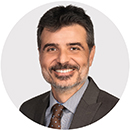
Luiz Sauerbronn is a Director, Investments Group, a Senior Analyst on the Industrials Research Team and a member of the International Large-Cap and Small-Cap Investment Committees. Additionally, he is a member of the Corporate Governance and Proxy Voting Committee and a limited partner of the firm’s parent company.
Before joining the firm, Mr. Sauerbronn was a Summer Associate with J.P. Morgan and Manager of the Mergers and Acquisitions Advisory Team of Brazil-based Banco Brascan (part of Brookfield Asset Management). He also worked with Royal Dutch Shell. Mr. Sauerbronn earned his BS in economics from the Federal University of Rio de Janeiro and his MBA from the Haas School of Business at the University of California, Berkeley. His relevant experience began in 1995 and he joined Brandes Investment Partners in 2001.
Luiz Sauerbronn, with 29 years of investment experience, provides an overview of the Brandes International Equity Fund and International ETF. Emphasizing a bottom-up investment strategy, Luiz highlights the funds’ strategic geographic positioning as well the investment theses behind specific portfolio holdings. He has been with Brandes since 2001.
The first thing to clarify is that we are bottom-up investors. We are long-term investors in businesses, not in countries, sectors, or regions. Having said that, we have significant exposure to the U.K., France, and Europe more generally today. After many years of significant exposure to companies based in Japan, we have been reducing our holdings there. Emerging markets are also a significant area of interest, specifically Latin America and emerging Asia.
Recent portfolio additions include Heineken and Ambev in the beverage category, Astellas in the pharmaceuticals, and luxury goods companies Richemont and Kering.
Certainly. Sanofi is one of our largest holdings and has been part of our investment portfolio for several years. Based in France, it's a well-diversified global pharmaceutical, and a top player in rare genetic diseases, diabetes, vaccines, and consumer health care. The company benefits from balanced geographic exposure, avoiding heavy reliance on the highly profitable yet riskier U.S. market, and holds a significant presence in emerging markets.
Our investment thesis is supported by the company's prospects for solid growth following a challenging period marked by patent expirations and heightened competition in the insulin market. The failure to meet market expectations last year was primarily due to reduced earnings per share (EPS) guidance, directly linked to higher research and development (R&D) expenses. This increase in R&D spending was spurred by compelling data from late-stage drug candidates in its pipeline. Contrary to market sentiment, which perceived the reduced EPS guidance more negatively, we interpret it as a positive indicator of the company's potential.
Within the consumer staples sector, we find the beverage category particularly compelling, with recent additions including Heineken and Ambev. Heineken serves as a prime example of the kinds of companies we look for. It is encountering near- term challenges in several of its key markets, specifically Nigeria and Vietnam. These countries have experienced currency issues but present attractive long-term growth opportunities.